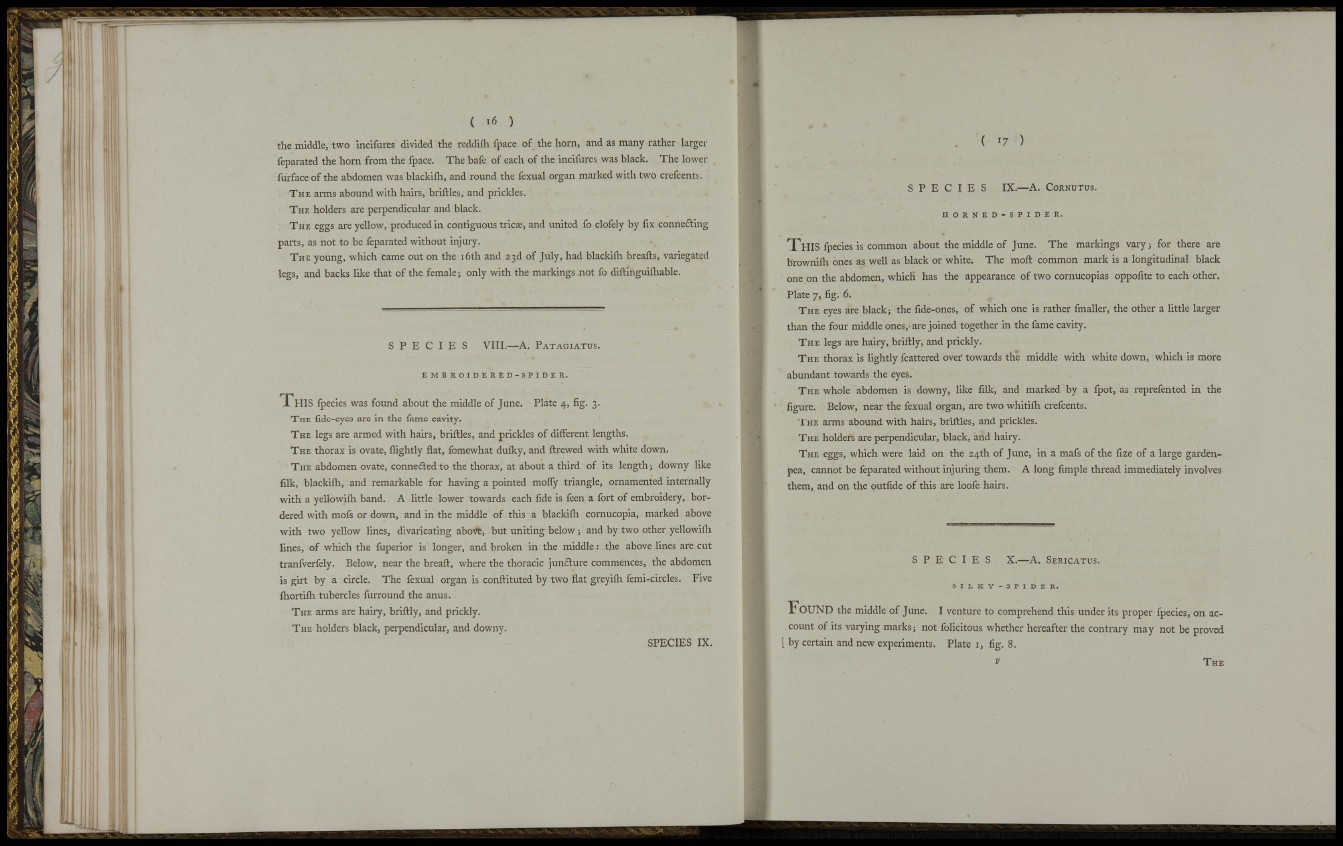
( I6 )
the middle, two incifures divided the reddiüi fpace of the horn, and as many rather larger
ieparated the horn from the fpace. The bafe of each of the incifures was black. The lower
furface of the abdomen was blackiih, and round the fexual organ marked with two crefcents.
THE arms abound with hairs, briftles, and prickles.
THE holders are perpendicular and black.
THE eggs are yellow, produced in contiguous trie®, and united fo clofely by fix connefting
parts, as not to be feparated without injui-y.
THE young, which came out on the i6th and 23d of July, had blackifh breafts, variegated
legs, and backs like that of the female; only with the markings not fo diftinguiihable.
S P E C I E S VIII.—A. PATAGIATUS.
E M B R O I D E R E D - S P I D E R .
T H I S fpedes was found about the middle of June. Plate 4, fig. 3.
THE fide-eyes are in the fame cavity.
THE legs are armed with hairs, briftles, and prickles of different lengths.
THE thorax is ovate, flightly flat, fomewhat dulky, and ftrewed with white down.
THE abdomen ovate, connedted to the thorax, at about a third of its length; downy like
filk, blackifh, and remarkable for having a pointed mofly triangle, ornamented internally
with a yellowifli band. A little lower towards each fide is feen a fort of embroidery, bordered
with mofs or down, and in the middle of this a blackiih cornucopia, marked above
with two yellow lines, divaricating aboVfe, but uniting below; and by two other yellowiih
lines, of which the fuperior is longer, and broken in the middle: the above lines are cut
tranfverfely. Below, near the breaft, where the thoracic jun<£lure commences, the abdomen
is girt by a circle. The fexual organ is conftituted by two flat greyifli femi-circles. Five
fliortifh tubercles furround the anus.
THE arms are hairy, briftly, and prickly.
THE holders black, perpendicular, and downy.
SPECIES IX.
S P E C I E S IX.—A. CORNUTUS.
H O R N E D - S P I D E R .
T H I S fpecies is common about the middle of June. The markings vary ; for there are
browniih ones as well as black or white. The moft common mark is a longitudinal black
one on the abdomen, which has the appearance of two cornucopias oppofite to each other.
Plate 7, fig. 6.
THE eyes are black; the fide-ones, of which one is rather fmaller, the other a little larger
than the four middle ones, are joined together in the fame cavity.
THE legs are hairy, briftly, and prickly.
THE thorax is lightly fcattered over towards the middle with white down, which is more
abundant towards the eyes.
THE whole abdomen is downy, like filk, and marked by a ipot, as reprefented in the
figure. Below, near the fexual organ, are two whitifli crefcents.
THE arms abound with hairs, briftles, and prickles.
THE holders are perpendicular, black, and hairy.
THE eggs, which were laid on the 24th of June, in a mafs of the fize of a large gardenpea,
cannot be feparated without injuring them. A long fimple thread immediately involves
them, and on the outfide of this are loofe hairs.
S P E C I E S X.—A. SERICATUS.
S I L K Y - S P I D E R .
FOUND the middle of June. I venture to comprehend this under its proper fpecies, on account
of its vaiying marks; not folicitous whether hereafter the contrary may not be proved
[ by certain and new experiments. Plate i, fig. 8.
F TH E